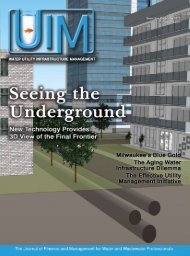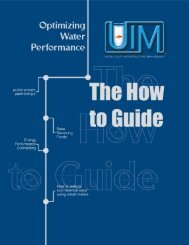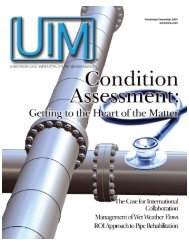Download - Water Utility Infrastructure Management
Download - Water Utility Infrastructure Management
Download - Water Utility Infrastructure Management
Create successful ePaper yourself
Turn your PDF publications into a flip-book with our unique Google optimized e-Paper software.
Protecting Our Future by Making Advanced Asset<br />
<strong>Management</strong> Decisions<br />
By Gregory M. Baird<br />
America’s economic dominance as a world power over the<br />
past several decades has been based on the strength and<br />
investment in its critical infrastructure. Without the infrastructure<br />
networks of drinking water systems, wastewater,<br />
ground transportation, waterways, oil, gas, electric, airports and<br />
seaports, our superpower engine of manufacturing both goods<br />
and services could never have been achieved. These early investments<br />
have built the foundation of our current expectations of a<br />
modern standard of living and have played a substantial role in<br />
the sustained prosperity and quality of life of our country.<br />
These complicated infrastructure networks are now more interdependent<br />
than ever before. Urbanization has layered these separate<br />
systems in an intensive public works infrastructure web. Each valued<br />
network (water, sewer, electric, etc.), each with its own unique purpose<br />
and critical functions, has different repair and renewal costs<br />
and timing requirements. Manual processes and individual human<br />
mental storage of these challenging relationships of risk and cost<br />
tradeoffs no longer meets the needs of public work and utility<br />
departments for municipal or private utility management companies.<br />
We are currently in a dynamic period of shifting “data rich and<br />
information poor” decision making to a more knowledgeable and<br />
discernible era of effective cost management for all assets.<br />
Our Challenging Future<br />
In order to make an organized transition from post-World War<br />
II practices to the emerging 21 st century of infrastructure technology<br />
and best practices, an approach to managing all of our capital<br />
assets is needed. At some point, an Excel spreadsheet just does not<br />
cut it for hundreds of thousands of assets worth billions of dollars.<br />
In the United States, the East Coast is lighting up with pipe failures<br />
due to both age and corrosion. <strong>Infrastructure</strong> intensive<br />
operations like water, wastewater and drainage with long-term<br />
assets coming to the end of their useful lives are presenting an<br />
overwhelming flood of funding and affordability issues. Likewise,<br />
the energy sector of oil, gas, electric and hydroelectric faces<br />
renewal issues. Unmanaged and un-forecasted, these basic systems<br />
will fail and utilities will be forced to restore service through<br />
unplanned emergency repairs requiring higher rates for customers.<br />
Public officials should protect the future affordability of these<br />
basic services by requiring infrastructure management best practices.<br />
Advanced asset management (AM) concepts, software tools<br />
and techniques that focus on managing cost-effective sustained<br />
performance to the customer at the lowest life-cycle cost and at an<br />
acceptable level of risk to the organization is the ultimate answer.<br />
Asset <strong>Management</strong> is the Answer<br />
In 2010, the New Jersey Clean <strong>Water</strong> Council, which has the<br />
statutory function of advising the Commissioner of the Department<br />
of Environmental Protection regarding issues related to clean<br />
water, explained that the New Jersey Section of the American<br />
Society of Civil Engineers (ASCE) in 2007 gave grades of D to<br />
wastewater utilities and C to drinking water utilities in New Jersey.<br />
The Council understood that for New Jersey to maintain a viable<br />
economy with a sound environment it must begin managing its<br />
infrastructure in a manner that produces the lowest life-cycle cost.<br />
The Council further believed that deferred maintenance (“run to<br />
failure”) might hold rates down in the short term but inevitably<br />
increases long-term costs and causes service disruptions that harm<br />
the customers and the environment, and is therefore self-defeating.<br />
The Council proposed that asset management, utility rates<br />
and utility accounting should be used to achieve sustainable utility<br />
functions and finances that minimize long-term costs.<br />
Managing Long-term Costs<br />
Communities put their economy and environment at risk when<br />
they ignore infrastructure asset management. The basic component<br />
of an asset management program includes the computerized maintenance<br />
management system (CMMS), but a work order system<br />
alone needs additional asset management software to take it to the<br />
next level. There are many choices of various types of asset management<br />
planning software, but finding one that is truly advanced and<br />
embeds the financial analysis and reporting component for all<br />
assets, across all asset types and all utilities, can be more difficult.<br />
The basic steps and components of asset management software<br />
include:<br />
1. Collecting and organizing tangible asset data from a broad range<br />
of paper and electronic sources to create the asset registry (AR).<br />
2. Integrating disparate database systems including GIS and financial<br />
packages for centralized tangible capital asset data manipulation<br />
that develops an enterprise inventory (EI).<br />
3. Performing integrated strategic short-term capital asset planning<br />
and maintenance management scheduling as part of the<br />
decision support (DS) process.<br />
4. Performing integrated long range, 10- to 100-year, capital asset<br />
planning and maintenance management forecasting as part of<br />
the decision support (DS) process.<br />
5. Tracking capital projects from inception through design and<br />
approvals all the way to construction as part of a capital projects<br />
(CP) procedure.<br />
Decision Support Asset <strong>Management</strong><br />
Software<br />
A best-in-class of advanced asset management decision support<br />
software for all assets comes from the Canadian infrastructure marketplace,<br />
which as a whole seems to be recognizing the neglect of its<br />
long-term infrastructure funding and embracing the application of<br />
best practice investment solutions. RIVA Modeling, a Toronto-based<br />
company, offers real-time asset valuation analysis decision support<br />
software that is extremely scalable to support an all assets management<br />
program roll out while embedding baseline financial performance<br />
monitoring. With successful integrations with SAP, CityWorks<br />
Computerized Maintenance <strong>Management</strong>, financial systems and<br />
other vendors combined with ESRI or Intergraph GIS, RIVA offers<br />
solutions to the most complicated layers of repair, replacement and<br />
renewal decision-making over a 10- to 100-year planning horizon.<br />
RIVA is a web-based client-server application that can interface<br />
with most common applications. The data can come from any<br />
ODBC-compliant source, so the user can leverage existing data and<br />
pull data from other databases to create a central asset registry or<br />
inventory of all assets and their attributes, eliminating the extra<br />
costs of separately maintained and isolated asset databases. The<br />
advanced modeling capabilities are used for asset valuation, estimation<br />
of deferred maintenance, condition assessment, estimating<br />
remaining service life and for the prioritization of maintenance and<br />
renewal programs. These capabilities have offered Canadian utilities<br />
the ability to handle PSAB 3150 infrastructure reporting<br />
requirements, which are stricter than GASB34and fit nicely with new<br />
international PAS 55 and ISO infrastructure policy developments.<br />
30 <strong>Water</strong> <strong>Utility</strong> <strong>Infrastructure</strong> <strong>Management</strong><br />
November/December 2011








